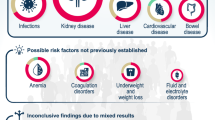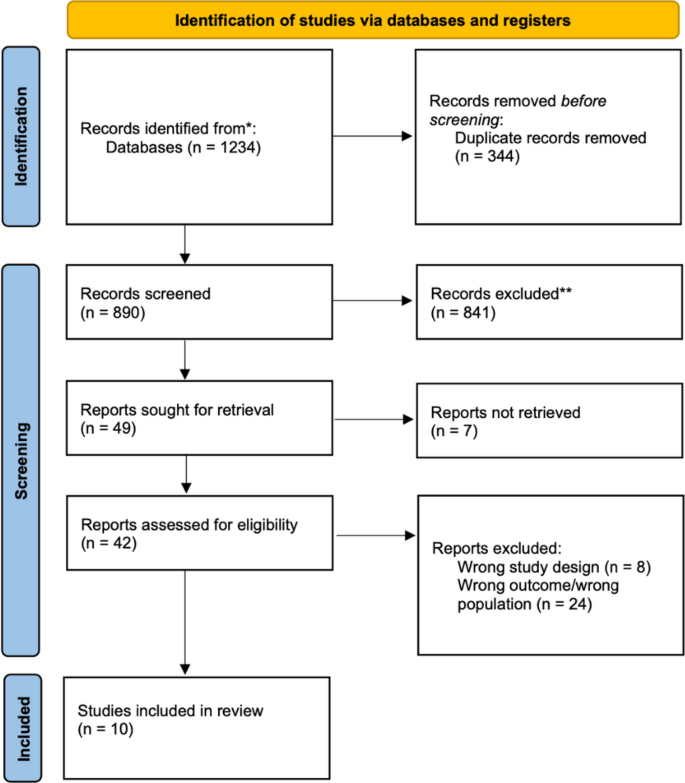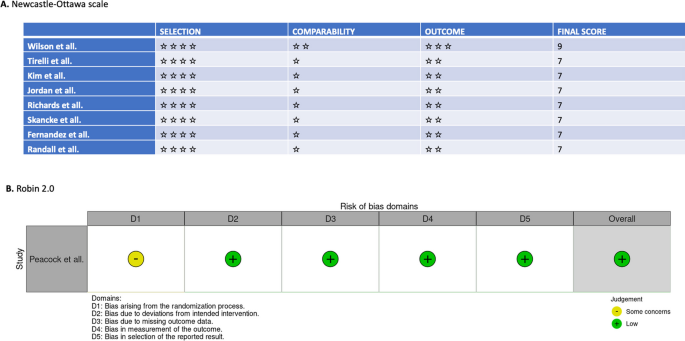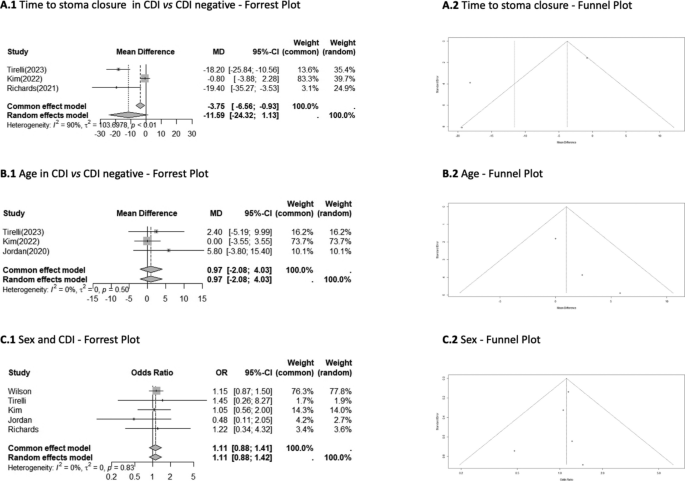Abstract
Background
Clostridium difficile infection (CDI) has been described in the early post-operative phase after stoma reversal. This systematic review aimed to describe the incidence of CDI after stoma reversal and to identify pre-operative variables correlated with an increased risk of infection.
Methods
A systematic review of the literature was conducted according to the PRISMA guidelines in March 2024. Manuscripts were included if reported at least one patient with CDI-associated diarrhoea following stoma reversal (colostomy/ileostomy). The primary outcome of interest was the incidence of CDI; the secondary outcome was the comparison of clinical variables (age, sex, time to stoma reversal, neo-adjuvant and adjuvant therapies after index colorectal procedure) in CDI-positive versus CDI-negative patients. A meta-analysis was performed when at least three studies reported on those variables.
Results
Out of 43 eligible manuscripts, 1 randomized controlled trial and 10 retrospective studies were selected, including 17,857 patients (2.1% CDI). Overall, the mean age was 64.3 ± 11.6 years in the CDI group and 61.5 ± 12.6 years in the CDI-negative group (p = 0.51), with no significant difference in sex (p = 0.34). Univariable analyses documented that the mean time to stoma reversal was 53.9 ± 19.1 weeks in CDI patients and 39.8 ± 15.0 weeks in CDI-negative patients (p = 0.40) and a correlation between neo-adjuvant and adjuvant treatments with CDI (p < 0.001). A meta-analysis was performed for time to stoma reversal, age, sex, and neo-adjuvant therapies disclosing no significant differences for CDI (stoma delay, MD 11.59; 95%CI 24.32–1.13; age, MD 0.97; 95%CI 2.08–4.03; sex, OR1.11; 95%CI 0.88–1.41; neo-adjuvant, OR0.81; 95%CI 0.49–1.35). Meta-analysis including patients who underwent adjuvant therapy evidenced a higher risk of CDI (OR 2.88; 95%CI 1.01–8.17, p = 0.11).
Conclusion
CDI occurs in approximately 2.1% of patients after stoma reversal. Although a trend of increased delay in stoma reversal and a correlation with chemotherapy were documented in CDI patients, the use of adjuvant therapy was the only possible risk factor documented on meta-analysis.
PROSPERO registration number
CRD42023484704
Similar content being viewed by others
Avoid common mistakes on your manuscript.
Introduction
Colorectal surgery has been identified as a risk factor for Clostridium difficile infection (CDI) [1,2,3], although its occurrence is relatively rare, since as it has been reported in only 1.5% of patients [4]. However, stoma closure surgery has the highest incidence rate of CDI among abdominal procedures, ranging from 1.6 to 8.7% of cases [5,6,7,8,9,10,11,12,13,14,15].
The creation of a diverting ileostomy or colostomy disrupts the normal anatomical structure of the bowel, leading to significant changes in the mucosal and muscular layers. This process also results in progressive atrophy of the dysfunctional colonic tract. The atrophy and decreased immune capacity of the colon mucosa increase its susceptibility to Clostridium difficile infection [16]. Of note, Clostridium difficile (CD) not only is a healthcare-related pathogen but also colonizes the gastrointestinal tract in 15% of the population. Usually, CD colonization is completely asymptomatic, but it can become symptomatic if normal intestinal flora disruption occurs [1,2,3].
The intestinal flora ecosystem plays a critical role in preserving the intestines by resisting colonization and infection by pathogenic organisms. Under normal circumstances, the human gut microbiota can hinder pathogen colonization through general mechanisms such as direct inhibition via bacteriocins, nutrient depletion, or stimulation of host immune defences. However, the specific mechanism by which the microbiota protects against CDI remains unknown. Disruption of the normal balance of the colonic microbiota can result from prolonged antimicrobial therapies, mucosal atrophy due to colonic faecal diversion, or immunosuppression [1,2,3,4].
There are several reasons why the incidence of CDI after stoma closure is greater than that after other colorectal procedures [17], including the clinical variables and intrinsic risk factors of patients undergoing stoma reversal surgery (elderly people with colon cancer, subjected to chemotherapy and radiotherapy, sometimes malnourished, or long-lasting stoma holders) [5].
We thus aimed this manuscript to systematically review the literature and describe the incidence of CDI after stoma reversal; the secondary outcome of interest was the comparison of the clinical variables in CDI-positive patients and CDI-negative patients.
Methods
Data sources, search strategy, and selection criteria
A systematic review of published papers was conducted according to the Preferred Reporting Items for Systematic Reviews and Meta-Analyses (PRISMA) guidelines in March 2024 (Supplementary Material). The following sources were searched for papers reporting cases of documented CDI following reversal of colostomy or ileostomy: PubMed, Embase and Medline. The search terms included (clostridium) AND (colorectal cancer), (clostridium) AND (colorectal surgery), (clostridium) AND (rectal cancer), (clostridium) AND (rectal surgery), (clostridium) AND (colostomy), (clostridium) AND (ileostomy), (clostridium) AND (stoma) (clostridium) AND (stoma closure), (clostridium) AND (stoma reversal), (clostridium) AND (stoma surgery) in all fields. The references of the included articles were also manually searched, and further articles were included if appropriate. Both ileostomy and colostomy reversal were considered for inclusion. The selection criteria included “English” languages, human studies, clinical trials, and observational and comparative studies. Duplicate references were semi-automatically removed using the RAYYAN platform (https://www.rayyan.ai/). Case reports were excluded. Each paper retrieved was assessed for inclusion or exclusion by revision of titles and abstracts by two authors (LL and FT), and any issues or disagreements were resolved by consensus.
Study risk-of-bias assessment
Randomized controlled trials (RCTs) were evaluated using the Robin 2.0 tool, whereas nonrandomized retrospective cohorts were evaluated using the Newcastle‒Ottawa scale. GRADE criteria were considered to summarize evidences.
Outcomes of interest
The primary outcome of interest was the rate of CDI infection. The secondary outcome was to determine the association between clinical variables (age, sex, time to stoma closure, neo-adjuvant, and adjuvant therapies) and CDI infection following stoma reversal in CDI-positive vs. CDI-negative patients.
Statistics
Categorical variables were analysed using frequencies and percentages, and subgroups were compared using chi-square tests. Continuous variables were presented using means, standard deviations (SDs), medians, and ranges (IRQ). Meta-analyses were conducted when at least three studies provided computable variables. The Mantel-Haenszel method was used for calculating the weighted summary odds ratio (OR) under the fixed effects model. Next, the heterogeneity statistic is incorporated to calculate the summary odds ratio under the random effects model. The total odds ratio with 95%CI is given both for the fixed effects model and the random effects model. If the value 1 is not within the 95%CI, then the odds ratio is statistically significant at the 5% level (P < 0.05). For meta-analysis of studies with a continuous measure (comparison of means between treated cases and controls), the Hedge's g statistic was used as a formulation for the mean difference (MD) under the fixed effects model. Next, the heterogeneity statistic is incorporated to calculate the summary standardized mean difference under the random effects model. If the value 0 is not within the 95%CI, then the MD is statistically significant at the 5% level (P < 0.05). Statistical heterogeneity of the results of the papers was assessed on the basis of a test of heterogeneity (standard chi-squared test on N degrees of freedom where N equals the number of trials contributing data minus one). Three possible causes for heterogeneity were pre-specified: (1) differing response according to difference in the quality of the trial; (2) differing response according to sample size; and (3) differing response according to clinical heterogeneity. If the test of heterogeneity is statistically significant (P < 0.05), then more emphasis should be placed on the random effects model.
Furthermore, a meta-analysis of proportions was considered related to CD infection and total number of patients estimating the proportion of CDI in each study with the inverse of the variance weight, a measure of the precision of a weighted mean estimate; then, it was calculated the standard deviation with the proportion estimate setting using the DerSimonian-Laird method, taking into account the variation between studies.
Statistical analysis was performed using R open-source software and the “meta” package in R (https://cran.r-project.org/). All tests were two-tailed, and p < 0.05 was considered to indicate statistical significance.
Results
Study population and systematic review
Out of a total of 1263 papers screened, 11 (10 retrospective cohort studies and 1 randomized controlled trial [5,6,7,8,9,10,11,12,13,14,15]) met the inclusion criteria and were analysed (Fig. 1), including a previous paper from our group [5].
Table 1 shows the eleven papers analysed, including 17,857 patients who underwent stoma reversal surgery (both ileostomy and colostomy reversal were considered for inclusion); the overall incidence of CDI was 2.1% (381/17,857) [5,6,7,8,9,10,11,12,13,14,15].
Overall, the mean age of the CDI-positive patients was 64.3 ± 11.6 years, while that of the CDI-negative patients was 61.5 ± 12.6 years (p = 0.51), whereas the M/F ratio was 1.4 for the CDI-positive patients and 1.2 for the CDI-negative patients (p = 0.34) (Table 2). Additionally, the mean time to stoma reversal after the index CRC procedure was 53.9 ± 19.1 weeks in CDI-positive patients and 39.8 ± 15.0 weeks in CDI-negative patients (p = 0.40) (Table 2). Also, on univariable analysis, both neo-adjuvant and adjuvant therapy correlated with CDI: In particular, 11.8% of the patients who were treated with neo-adjuvant therapy developed a CDI vs. 6.2% of those who did not, and 16.7% of patients who underwent adjuvant treatment had a CDI vs. 6.5% of patients not treated with adjuvant chemotherapy (Table 2).
Study risk-of-bias assessment
There was one RCT [7] and ten non-randomized retrospective cohort studies [5, 6, 8,9,10,11,12,13,14,15]. All non-randomized studies scored 7 or more on the Newcastle‒Ottawa scale, and the RCTs had a low risk of bias according to Robin 2.0. All studies were therefore deemed good quality studies (Fig. 2).
Meta-analysis
Overall, five variables were computable for meta-analysis: age, sex, stoma closure delay, neo-adjuvant therapies, and adjuvant therapies in CDI-positive vs. CDI-negative patients. The studies included in the meta-analyses [5, 8,9,10] were based on 1591 patients for the time to stoma reversal variable, 1624 patients for the age variable, 15,064 patients for sex variable, and 549 patients for neo-adjuvant and adjuvant therapies. A meta-analysis of proportion documented that CDI infection rate was homogeneous among studies (Supplementary Materials, Supplementary Fig. 1).
Figure 3 shows the meta-analysis on the delay of stoma closure and the meta-analysis on the mean age of patients and sex, documenting no significant differences between the CDI-positive and CDI-negative groups (stoma delay, MD11.59; 95%CI 24.32–1.13; age, MD0.97; 95%CI 2.08–4.03; sex, OR 1.11; 95%CI 0.88–1.41).
Figure 4 shows the meta-analysis for patients undergoing neo-adjuvant therapy (Fig. 4A) and documented no significant differences between the CDI-positive and CDI-negative groups (OR0.81; 95%CI 0.49–1.35), whereas adjuvant therapies (Fig. 4B) showed a significative correlation between with the development of CD infection (OR2.88; 95%CI 1.01–8.17, p = 0.11).
Discussion
This study analysed eleven papers including cases of Clostridium difficile infection after stoma reversal surgery. Clostridium difficile infection is an uncommon complication after stoma reversal surgery that occurs, according to this systematic review, approximately in 2.1% of the patients. Stoma closure surgery is an abdominal procedure with a relatively high incidence rate of CDI, ranging between 1.6 and 8.7% [5,6,7,8,9,10,11,12,13,14,15]. Although it is not a frequent complication, CDI is a potentially life-threatening complication, and it prolongs the costs and length of hospitalization.
Our group recently conducted a retrospective cohort study in a population of patients who underwent stoma reversal surgery after transanal total mesorectal excision (TaTME) for rectal cancer [5]. This surgical procedure has been adopted in our surgical unit since 2015, and it has become the treatment of choice for mid- and low rectal cancer, achieving successful surgical and functional outcomes [18]. The higher incidence of CDI in the postoperative period reported in this cohort (4.8%) could be explained by the characteristics of the study population (rectal cancers who underwent neo-adjuvant therapy in 72.2% of the cases and adjuvant therapy in nearly 48.4%), with a consequent delay in stoma closure. In this preliminary experience, we documented that delayed stoma closure was the main variable correlated with CDI; furthermore, the probability of presenting with diarrhoea symptoms was greater for males, increased with the comorbidity index, a lower mean albumin value, increased stoma delay closure, and the use of neo-adjuvant and adjuvant treatments.
Similarly, Jordan et al. [9] reported a 3.5% incidence of CDI (RR = 4.23). In their analysis, the CDI-positive group had a significantly longer median time to reversal, but this difference was not found to be statistically significant.
Indeed, most patients who undergo stoma closure surgery are previously treated with chemotherapies or radiotherapies that are toxic to the gut mucosa. In addition, it should be considered to the long-lasting defunctioning time, in cases requiring anti-neoplastic therapies or for organizational issues (i.e. COVID-19 pandemic).
The pathogenic mechanism of CDI in a defunctioning colon was explained by Kissmeyer-Nielsen [5] in 1994 through an experimental study on mice. Interruption of normal anatomical continuity by diverting ileostomy or colostomy causes radical morphological changes related to the mucosa and the muscular layers of the bowel. The composition of the colon wall in rats significantly changes following mucosal and muscular atrophy, as does the luminal surface area. Consequently, this alteration disrupts the normal balance of the colonic microbiota. In the context of dysbiosis, Clostridium difficile, which typically colonizes asymptomatic individuals, becomes a hazardous pathogen. However, there are several micro-organisms that have the potential to become harmful to the gastrointestinal mucosa [19, 20].
Although the use of antibiotics is an established risk factor for CDI [1], there are no clinical studies and sufficient data to correlate the use of a specific class of antibiotics in surgical prophylaxis with an increased incidence of CDI after stoma reversal surgery. Fernandes et al. [12] wrote the first paper demonstrating metronidazole as an effective preventative agent against postoperative diarrhoea and CDI in patients undergoing ileostomy reversal surgery. The results of this study indicated that single-dose metronidazole is more effective at reducing postoperative diarrhoea and CDI than multiple doses of cefuroxime plus metronidazole. Therefore, metronidazole may offer effective prophylaxis against CDI by reducing the CD load in the colon, permitting recolonization with indigenous gut microbiota. The preliminary results from this study need to be confirmed in large randomized controlled trials.
An interesting aspect for future studies could be to perform a preliminary CD test before surgery, in order to treat patients with a positive test to an adequate pre- and post-operative antibiotic therapy.
There may be some potential limitations in the present systematic review. The effects estimated in the model are based mainly on retrospective observational studies. They are therefore subjected to biases and confounding factors that may have influenced our model estimates. The main limitation of the included studies is the heterogeneity of the population. Heterogeneity in studies has been reported for a variety of reasons, including differences in the sample population regarding age, sex, BMI, and disease severity. Another limitation is the different study designs of the included papers (ten observational studies and 1 randomized clinical trial); otherwise, only observational studies were included in the meta-analysis. Other limitations are the low proportion of patients with CDI (limits statistical power when performing comparative tests), and lack of data pertaining to treatment and outcomes following CDI in these patients. Eventually, both ileostomy and colostomy are included in the same pool, and this is a difficult condition to adjust due to the lack of specific data in the included studies. Finally, a more extended literature search could retrieve other manuscripts missing in the current meta-analysis.
Drawing conclusions based on the moderate effect estimate from the meta-analysis and the certainty of the evidence according to GRADE criteria, adjuvant therapies probably increase Clostridium difficile infections rate after stoma closure surgery; however, studies analysed were observational and not RCT.
Conclusions
To conclude, the CDI is relatively low after stoma reversal surgery, and although a correlation between stoma delay closure, the use of chemotherapy and CDI population was observed; adjuvant therapy was the only significant variable showing the potential of being a possible risk factor.
Data availability
The data that support the findings of this study are not openly available to protect study participant privacy, but are available from the corresponding author upon reasonable request.
References
Sartelli M, Malangoni MA, Abu-Zidan FM et al (2015) WSES guidelines for management of Clostridium difficile infection in surgical patients. World J Emerg Surg 10:38
Yasunaga H, Horiguchi H, Hashimoto H, Matsuda S, Fushimi K (2012) The burden of Clostridium difficile-associated disease following digestive tract surgery in Japan. J Hosp Infect 82:175–180
Yeom CH, Cho MM, Baek SK, Bae OS (2010) Risk factors for the development of Clostridium difficile-associated colitis after colorectal cancer surgery. J Korean Soc Coloproctol 26:329–333
Damle RN, Cherng NB, Flahive JM, Davids JS, Maykel JA, Sturrock PR et al (2014) Clostridium difficile infection after colorectal surgery: a rare but costly complication. J Gastrointest Surg 18:1804–1811
Tirelli F, Lorenzon L, Biondi A, Langellotti L, Santoro G, Agnes A, Pezzuto R, Persiani R, D’Ugo D (2023) Predictors of Clostridium difficile infection after stoma reversal following TaTME surgery. Updates Surg 75(6):1589–1596. https://doi.org/10.1007/s13304-023-01614-4
Wilson MZ, Hollenbeak CS, Stewart DB (2013) Impact of Clostridium difficile colitis following closure of a diverting loop ileostomy: results of a matched cohort study. Colorectal Dis 15(8):974–981
Peacock O, Bhalla A, Simpson JA, Gold S, Hurst NG, Speake WJ, Tierney GM, Lund JN (2013) Twenty-three-hour stay loop ileostomy closures: a pilot study. Tech Coloproctol 17(1):45–49
Kim YI, Yu CS, Kim YS, Kim CW, Lee JL, Yoon YS, Park IJ, Lim SB, Kim JC (2022) Clostridium difficile infection after ileostomy closure and anastomotic failure in rectal cancer surgery patients. BJS Open 6(2):zrac026. https://doi.org/10.1093/bjsopen/zrac026
Jordan S, Hui N, Doudle M, Von Papen M, Naik A, Lu CT, Nolan G, Cooper M (2022) Incidence of Clostridioides difficile in patients post loop ileostomy reversal in an Australian tertiary hospital: a retrospective study. ANZ J Surg 92(3):403–408
Richards SJG, Udayasiri DK, Jones IT, Hastie IA, Chandra R, McCormick JJ, Chittleborough TJ, Read DJ, Hayes IP (2021) Delayed ileostomy closure increases the odds of Clostridium difficile infection. Colorectal Dis 23(12):3213–3219
Skancke M, Vaziri K, Umapathi B, Amdur R, Radomski M, Obias V (2018) Elective stoma reversal has a higher incidence of postoperative Clostridium difficile infection compared with elective colectomy: an analysis using the American College of Surgeons National Surgical Quality Improvement Program and targeted colectomy databases. Dis Colon Rectum 61(5):593–598
Fernandes R, Robinson P, Rangarajan K, Scott S, Angco L (2017) The role of single-shot metronidazole in the prevention of Clostridium difficile infection following ileostomy reversal surgery. Int J Colorectal Dis 32(5):733–736
Randall JK, Young BC, Patel G, Fitzgerald A, George BD (2011) Is Clostridium difficile infection a particular problem after reversal of ileostomy? Colorectal Dis 13(3):308–311
Taylor D, Azher H, Gartrell R, Yeung JM (2021) Clostridium difficile infection following reversal of loop ileostomy: an uncommon but significant complication. ANZ J Surg 91(10):2219–2221
Lee D, Bin Abdur Raheem M, Coveney A (2024) Single-centre retrospective audit of Clostridium difficile infections post ileostomy reversal. Cureus 16(1):e51674. https://doi.org/10.7759/cureus.51674
Kissmeyer-Nielsen P, Christensen H, Laurberg S (1994) Diverting colostomy induces mucosal and muscular atrophy in rat distal colon. Gut 35:1275–1281
Harries RL, Ansell J, Codd RJ, Williams GL (2017) A systematic review of Clostridium difficile infection following reversal of ileostomy. Colorectal Dis 19(10):881–887
Tirelli F, Lorenzon L, Biondi A, Neri I, Santoro G, Persiani R (2023) Functional outcomes after transanal total mesorectal excision (TaTME): a random forest analysis to predict patients’ outcomes. Tech Coloproctol 27(11):1037–1046. https://doi.org/10.1007/s10151-023-02775-5. Epub 2023 Mar 5. PMID: 36871281; PMCID: PMC9985820
Ali A, AlHussaini KI (2024) Helicobacter pylori: a contemporary perspective on pathogenesis, diagnosis and treatment strategies. Microorganisms 12(1):222. https://doi.org/10.3390/microorganisms12010222. PMID: 38276207; PMCID: PMC10818838
Agnes A, La Greca A, Tirelli F, Papa V (2020) Duodenal perforation in a SARS-CoV-2-positive patient with negative PCR results for SARS-CoV-2 in the peritoneal fluid. Eur Rev Med Pharmacol Sci 24(23):12516–12521. https://doi.org/10.26355/eurrev_202012_24048
Acknowledgements
The authors would like to thank Miss Cristina Vacca, Data Manager at Fondazione Policlinico Universitario ‘A. Gemelli’ IRCCS, for her support in data acquisition and update of the unit’s database.
Funding
Open access funding provided by Università Cattolica del Sacro Cuore within the CRUI-CARE Agreement. The authors have no funding to declare.
Author information
Authors and Affiliations
Contributions
Flavio Tirelli and Lodovica Langellotti and Laura Lorenzon wrote the main manuscript. Gloria Santoro contributed to statistical analysis. All authors reviewed the manuscript.
Corresponding author
Ethics declarations
Competing interests
The authors declare no competing interests.
Additional information
Publisher’s Note
Springer Nature remains neutral with regard to jurisdictional claims in published maps and institutional affiliations.
Highlights
• CDI occurs in approximately 2.1% of patients who undergo stoma reversal.
• A correlation with delayed stoma reversal and chemotherapy were observed in the CDI population.
• The meta-analysis documented a significant correlation between adjuvant therapy and CDI.
Supplementary information
Below is the link to the electronic supplementary material.
Rights and permissions
Open Access This article is licensed under a Creative Commons Attribution 4.0 International License, which permits use, sharing, adaptation, distribution and reproduction in any medium or format, as long as you give appropriate credit to the original author(s) and the source, provide a link to the Creative Commons licence, and indicate if changes were made. The images or other third party material in this article are included in the article's Creative Commons licence, unless indicated otherwise in a credit line to the material. If material is not included in the article's Creative Commons licence and your intended use is not permitted by statutory regulation or exceeds the permitted use, you will need to obtain permission directly from the copyright holder. To view a copy of this licence, visit http://creativecommons.org/licenses/by/4.0/.
About this article
Cite this article
Tirelli, F., Langellotti, L., Lorenzon, L. et al. Clostridium difficile infection after stoma reversal surgery: a systematic review and meta-analysis of the literature. Int J Colorectal Dis 39, 81 (2024). https://doi.org/10.1007/s00384-024-04643-6
Accepted:
Published:
DOI: https://doi.org/10.1007/s00384-024-04643-6








